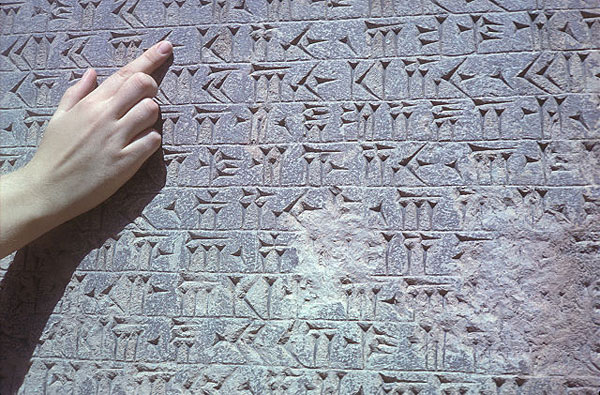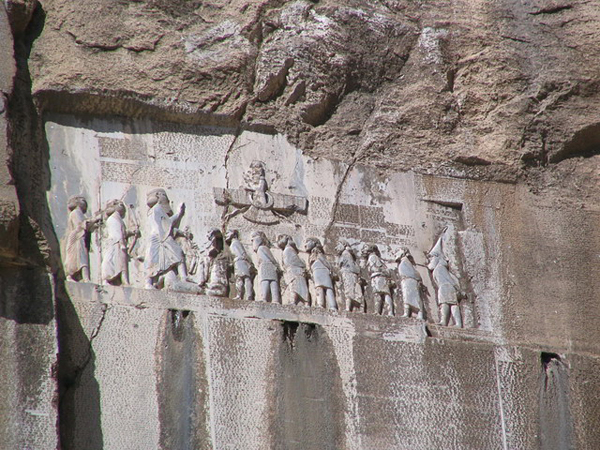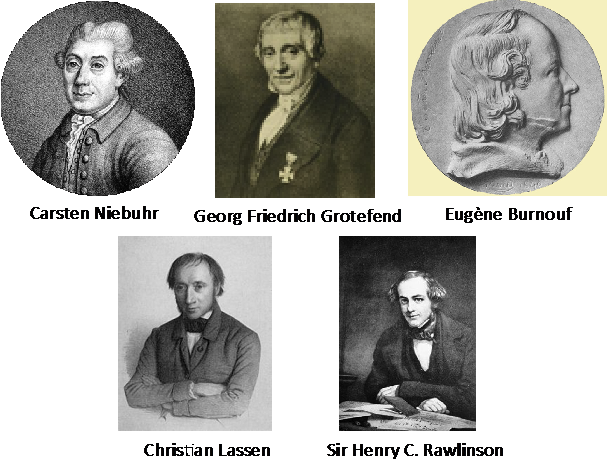I, Darius
Today, a king speaks. The University of Houston's College of Engineering presents this series about the machines that make our civilization run, and the people whose ingenuity created them.
At first glance, they look like random nails or wedges carved on a stone. A pattern begins to emerge in the cuneiform script: three wedges stand while one lies on top. Two small wedges point to a tall vertical one. Occasionally, a slanted wedge appears. Could these be words?
German mathematician and surveyor Carsten Niebuhr visited the site of these markings on Mount Behistun or Bisotun in 1764. The mountain is located in the western province of Kermanshah in Iran. The inscriptions are carved on a cliff-face about 50 feet high and 80 feet wide standing 330 feet above the ground. He published copies of the inscriptions in 1778.

Mount Behistun Persian Cuneiform [Wikipedia image]
Four years later, philologist Georg Friedrich Grotefend made a breakthrough. He suggested that the Old Persian inscription was alphabetical. The words were separated by slanted wedge. The inscription read from left to right. He surmised that a frequent word in the inscription could refer to the Persian word for king. Grotefend identified specific schemes: King X, son of king Y, and king Y son of Z. Given that Z was not a king, he was able to decipher X as Xerxes, Y as Darius and Z as Hystaspes.
By the mid-19th century several European scholars completed the task of full decipherment. The old Persian cuneiform script was finally understood. 411 lines are inscribed in 5 columns of text. They can be grouped into 76 statements made by Darius. They were written sometime between early 5th century and late 4th century BC. The inscription begins with:
"I am Darius, the great king, king of kings, the king of Persia, the king of countries, the son of Hystaspes'' Darius describes his lineage and various critical events in his time.
Darius says: "On this account Ahuramazda brought me help, and all the other gods, all that there are, because I was not wicked, nor was I a liar, nor was I a despot."
Williams Jackson of Columbia University writes:
"Easter Monday, April 13, 1903, will remain for me a memorable date in the calendar, for on that morning, after four days on horseback from Hamadan, I caught my first glimpse of the mountain of Behistun and the great inscription of Darius. For miles before one reaches it the huge mass of rock is constantly in sight, lifting its giant head 1700 feet above the plain.''

Mount Behistun Inscriptions and Figures [Wikipedia image]
Mount Bisotun inscriptions became a UNESCO World Heritage Site in 2006. We can now hear King Darius from the distant past.
I'm Haleh Ardebili at the University of Houston, where we're interested in the way inventive minds work.

People who contributed to deciphering of Behistun Inscriptions. [Wikipedia images].
References and Notes
http://www.heritageinstitute.com/zoroastrianism/languages/oldPersian.htm
A.V. Williams Jackson, Journal of the American Oriental Society, vol. 24, pp. 77-95, 1903
Note: Behistun and bisotun originated from the Old Persian word "Bagastan" meaning "Place of God".
This episode was first aired on January 12, 2013.